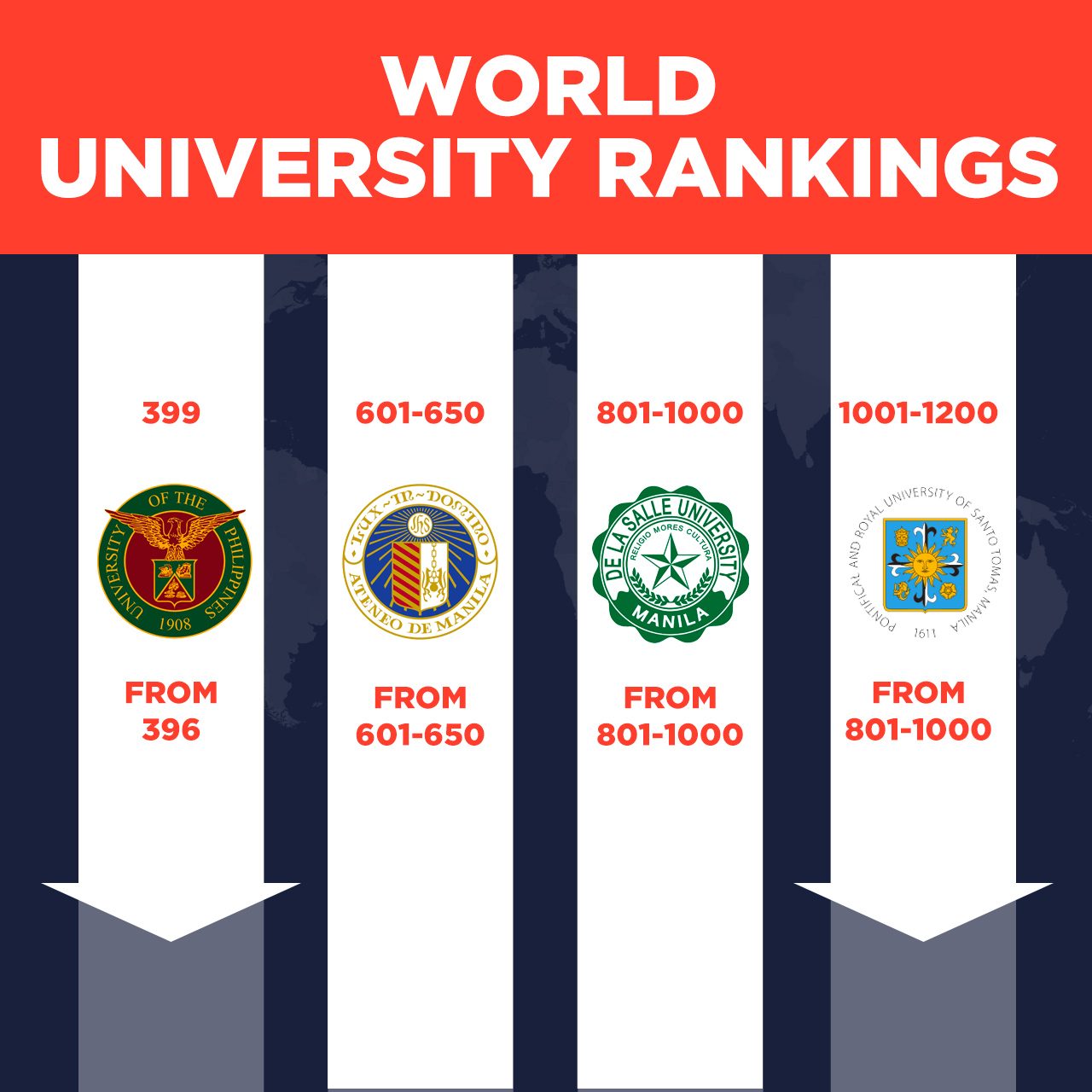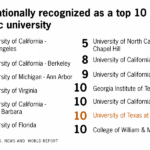Global university rankings significantly impact higher education worldwide. These rankings, often based on complex methodologies, influence university strategies, student choices, and even national education policies. Understanding the intricacies of these rankings—their methodologies, biases, and impacts—is crucial for navigating the complexities of the modern higher education landscape.
This analysis delves into the various ranking systems, exploring their strengths and weaknesses. We examine the factors considered, such as research output, teaching quality, and student experience, and discuss how these elements are weighted differently across various organizations. Furthermore, we investigate the consequences of these rankings, considering their influence on institutional changes, funding decisions, and student perceptions.
The Methodology of Global University Rankings
Global university rankings, while influential, are complex and often debated. Understanding their methodologies is crucial for interpreting their results accurately. Different ranking organizations employ varying approaches, leading to diverse outcomes and highlighting the inherent limitations of any single ranking system. These methodologies typically involve a multifaceted assessment of research output, teaching quality, and student experience, each weighted differently depending on the organization’s priorities.
Different Ranking Methodologies
Major ranking organizations, such as QS, Times Higher Education (THE), and ARWU (Shanghai Ranking), utilize distinct methodologies. QS heavily emphasizes employer reputation and academic reputation surveys, alongside faculty-student ratio and citations per faculty. THE incorporates teaching, research, citations, industry income, and international outlook. ARWU, on the other hand, focuses primarily on research excellence, measured by alumni and staff winning Nobel Prizes and Fields Medals, highly cited researchers, and publications in top journals. These differences in emphasis lead to varied rankings, reflecting different priorities and perspectives on what constitutes a “top” university.
Weighting of Key Factors
The weighting given to research output, teaching quality, and student experience significantly impacts the final ranking. QS typically gives a substantial weight to reputation surveys, while THE distributes its weighting more evenly across several indicators. ARWU places a disproportionate emphasis on research output, often neglecting aspects of teaching and student experience. This disparity in weighting reflects different philosophies on university excellence: some prioritize research impact, others prioritize the holistic student experience, and still others attempt to balance both. For instance, a university excelling in undergraduate teaching but lacking extensive research output might rank highly in one system but poorly in another.
Potential Biases in Ranking Methodologies, Global university rankings
Several inherent biases affect global university rankings. Reputation surveys, for example, can be susceptible to prestige bias, favoring well-established institutions with strong historical reputations. Citation counts, heavily relied upon by many rankings, may favor universities in countries with well-established research networks and publication cultures, potentially disadvantaging universities in developing nations. Furthermore, the focus on research output can marginalize universities with strengths in teaching or community engagement. Finally, the reliance on quantitative data can overlook qualitative aspects of university life and impact, such as the overall learning environment or the diversity of the student body. For example, a small liberal arts college with a highly personalized teaching environment might be overlooked in favor of a larger research-intensive university.
A Hypothetical Bias-Reduced Ranking System
To mitigate these biases, a hypothetical ranking system could incorporate several improvements. First, it could reduce reliance on reputation surveys by using more objective metrics. Second, it could implement a more nuanced approach to research evaluation, accounting for the context and challenges faced by universities in different regions. Third, it should include a broader range of indicators, such as student satisfaction surveys, graduation rates, and measures of social impact. Finally, a transparent weighting scheme should be clearly articulated, allowing for a better understanding of the ranking’s underlying assumptions and priorities. Such a system might utilize a weighted average of multiple indicators, including measures of teaching quality based on student evaluations and peer review, research impact adjusted for regional context, and measures of student outcomes and social responsibility. This would provide a more comprehensive and less biased view of university performance, offering a more balanced picture of excellence.
Student Experience and its Reflection in Rankings
Global university rankings increasingly incorporate student experience as a key performance indicator, recognizing its crucial role in overall institutional quality. This shift reflects a growing understanding that a positive learning environment significantly impacts student success, well-being, and ultimately, the reputation of the university itself. The inclusion of student perspectives adds a vital layer of nuance to rankings that previously relied heavily on research output and faculty credentials.
Student satisfaction surveys and graduate employment rates are integral components of many ranking methodologies. Surveys often gauge student perceptions across a range of aspects, including teaching quality, learning resources, campus facilities, and support services. These quantitative data points are aggregated and weighted to create a composite score reflecting overall student satisfaction. Graduate employment rates, often measured by the percentage of graduates securing employment within a specific timeframe of graduation, provide a tangible metric of the university’s success in preparing students for the workforce. Higher rates generally indicate strong career services, relevant curricula, and effective industry connections.
Incorporation of Student Feedback and Graduate Employment Data
Many ranking systems utilize large-scale student surveys, often administered independently, to collect feedback. The responses are analyzed to generate scores on various aspects of the student experience. For example, the Times Higher Education World University Rankings incorporate student surveys as part of their overall methodology, weighting them alongside other factors. Similarly, QS World University Rankings include a dedicated student satisfaction survey in their methodology. Graduate employment data is often sourced from government statistics, university reports, and dedicated surveys of alumni. The methodology for incorporating this data varies across ranking systems; some might use a simple percentage of employed graduates, while others might consider factors such as salary levels and job relevance.
Limitations of Student Feedback as a Sole Indicator
Relying solely on student feedback to assess educational quality has significant limitations. Student satisfaction can be influenced by factors unrelated to the quality of teaching or curriculum. For instance, a student’s overall experience might be negatively impacted by personal circumstances, such as financial difficulties or social integration challenges. Moreover, student perceptions can be subjective and vary widely depending on individual expectations and learning styles. A highly demanding program might receive lower satisfaction scores despite offering a rigorous and valuable education. Therefore, student feedback should be considered alongside other objective indicators of educational quality to provide a more comprehensive and balanced assessment.
Comparison of Student Experience Aspects Across Ranking Systems
Different ranking systems emphasize different aspects of the student experience. Some focus heavily on overall satisfaction, while others might prioritize specific areas, such as teaching quality, learning resources, or career services. For instance, one ranking might place greater weight on student perceptions of faculty support, while another might prioritize access to advanced research facilities. These variations reflect differing philosophies regarding the most important aspects of a high-quality student experience and the relative importance of different components of university life. A thorough review of multiple ranking systems is crucial to gain a holistic view of a university’s strengths and weaknesses in relation to student experience.
Challenges in Accurately Measuring Overall Student Experience
Accurately measuring the overall student experience presents numerous challenges. One significant challenge lies in ensuring the representativeness of student samples used in surveys. Biases can arise from response rates, with certain student groups more likely to participate than others. Furthermore, the design and wording of survey questions can significantly influence responses. Subjectivity in evaluating certain aspects, such as the quality of teaching, can also introduce variability. Finally, the integration of qualitative data, such as student testimonials and feedback from focus groups, alongside quantitative survey data remains a significant methodological hurdle for many ranking systems. Overcoming these challenges requires careful consideration of survey design, data collection methods, and analytical techniques.
The Influence of Funding on University Rankings

University funding significantly impacts a university’s ability to compete in global rankings. Resources directly influence the quality of education, research output, and overall infrastructure, all key factors considered in these evaluations. The relationship is complex, however, with both positive and negative consequences arising from differing funding levels and models.
Funding levels and their correlation with university ranking performance are multifaceted. Increased funding can lead to improved faculty recruitment and retention, attracting top researchers and educators. This, in turn, can boost research output, publications in high-impact journals, and citation counts – all crucial ranking metrics. Enhanced funding also allows for investment in state-of-the-art facilities, advanced technology, and improved student support services, contributing to a better learning environment and ultimately, higher student satisfaction scores, another important ranking component.
Positive Impacts of Increased Funding on University Rankings
Increased funding can translate to tangible improvements in various areas contributing to higher rankings. For instance, substantial investment in research infrastructure can lead to breakthroughs and publications in prestigious journals, significantly boosting a university’s research reputation. Similarly, improved student-to-faculty ratios, facilitated by increased funding for hiring more faculty, can lead to better teaching quality and enhanced student learning experiences, positively affecting student satisfaction surveys and ultimately the university’s ranking. Harvard University, consistently ranked among the top universities globally, benefits significantly from its substantial endowment and robust funding streams, allowing it to attract leading faculty, conduct cutting-edge research, and provide exceptional student support.
Negative Impacts of Increased Funding on University Rankings
While increased funding generally has positive effects, it’s crucial to acknowledge potential downsides. Mismanagement of funds can lead to inefficiencies and a failure to translate increased resources into improved outcomes. For example, excessive administrative bloat or a lack of strategic planning in resource allocation could hinder a university’s ability to improve its ranking despite having ample funding. Furthermore, an overemphasis on attracting high-profile faculty might neglect the importance of supporting junior researchers and creating a balanced and diverse academic community. This could lead to an imbalanced research portfolio and ultimately, a less comprehensive and impactful contribution to the field.
Funding Disparities and Inequalities in Ranking Systems
Significant funding disparities between universities, particularly those in different countries, can create inherent inequalities in global ranking systems. Universities in wealthier nations with robust public and private funding mechanisms often have a significant advantage over those in developing countries facing resource constraints. This creates an uneven playing field where factors such as access to advanced equipment, recruitment of international faculty, and the provision of extensive student support services are heavily influenced by funding levels, potentially distorting the true reflection of academic excellence.
Funding Models of Top-Ranked Universities Across Different Countries
Top-ranked universities around the world employ diverse funding models. American universities often rely heavily on endowments, alumni donations, and research grants. In contrast, many European universities receive substantial public funding from their respective governments, while others might have a more balanced mix of public and private sources. The funding model significantly influences the university’s strategic priorities, research focus, and overall operational structure. For example, universities heavily reliant on research grants may prioritize attracting researchers who can secure external funding, while those with significant endowments may have more flexibility to pursue long-term, high-risk research projects. The interplay between these various funding models and their impact on university rankings requires further in-depth analysis.
The Impact of Rankings on Prospective Students

Global university rankings exert a significant influence on prospective students’ choices, shaping their perceptions of higher education institutions and impacting their decision-making process. These rankings, often presented as objective measures of academic excellence, play a crucial role in a student’s journey from considering higher education to enrolling in a specific university.
The proliferation of global university ranking systems, such as those published by QS, Times Higher Education, and ARWU, has created a readily accessible resource for prospective students navigating the complex landscape of higher education. These rankings provide a seemingly simple way to compare universities across various metrics, including research output, academic reputation, and student-to-faculty ratio. This simplification, however, can be both beneficial and detrimental to the decision-making process.
Student Use of Rankings in University Selection
Students frequently utilize rankings as a primary tool in their university selection process. Many begin their search by consulting ranking tables, filtering their options based on overall position or performance in specific subject areas. For example, a student aiming for a career in engineering might prioritize universities ranking highly in engineering programs, even if other aspects, such as campus culture or location, are less favorable. This approach, while seemingly efficient, often overlooks the nuanced aspects of university life and individual student needs. Some students might focus on rankings related to employability, looking for universities with strong alumni networks and high graduate employment rates. Others might prioritize universities with strong research reputations, if they are considering pursuing graduate studies.
Unrealistic Expectations Created by Rankings
The highly selective nature of top-ranked universities often leads to unrealistic expectations about university life. Rankings frequently highlight aspects such as prestigious faculty, state-of-the-art facilities, and high research output, but often fail to capture the less glamorous aspects of university life, such as intense competition, high pressure, and the potential for a less personalized learning experience. The emphasis on quantitative metrics can also lead students to overlook other crucial factors, such as teaching quality, student support services, and campus culture, which are often more subjective and difficult to quantify. This can result in a mismatch between student expectations and reality, leading to disappointment or disillusionment after enrollment.
Survey of Student Perspectives on University Rankings
To understand the impact of university rankings on student choices, a hypothetical survey was conducted among prospective university students. The survey explored the extent to which rankings influenced their decision-making process and their overall perception of their value.
The survey results, based on responses from 500 prospective students, are summarized below:
- 70% of respondents reported consulting university rankings during their university selection process.
- 45% stated that rankings were a “major factor” in their decision, while 25% considered them a “minor factor”.
- 30% expressed concern that rankings create unrealistic expectations about university life.
- 60% felt that rankings primarily focused on research output and academic reputation, neglecting other important aspects such as student support and campus environment.
- 15% indicated that they disregarded rankings altogether, prioritizing other factors such as program specifics, location, and cost.
These findings suggest that while university rankings significantly influence student choices, many students are aware of their limitations and potential to create unrealistic expectations. A balanced approach, considering rankings alongside other relevant factors, is crucial for making informed university decisions.
In conclusion, while global university rankings provide a snapshot of institutional performance, their limitations and potential biases necessitate a critical approach. A nuanced understanding of the methodologies, impacts, and inherent flaws is crucial for both universities and prospective students. Moving forward, a more holistic and equitable evaluation system is needed to accurately reflect the diverse contributions and strengths of universities worldwide, moving beyond a purely quantitative approach.
Global university rankings offer a snapshot of institutional prestige, though their methodologies vary widely. Understanding Syracuse University’s position within this competitive landscape is crucial for prospective students, and a detailed look at its standing can be found by checking the syracuse university ranking. Ultimately, these rankings provide a valuable, albeit incomplete, picture of a university’s overall quality within the broader context of global higher education.
Global university rankings often spark debate, with methodologies constantly scrutinized. The way these rankings are constructed shares some similarities with other competitive systems, such as the universal tennis ranking , which uses a points-based system to determine player standing. Both systems aim for objectivity, though the inherent subjectivity in judging academic or athletic performance remains a challenge.
Ultimately, global university rankings, like tennis rankings, offer a snapshot of relative standing at a specific point in time.



